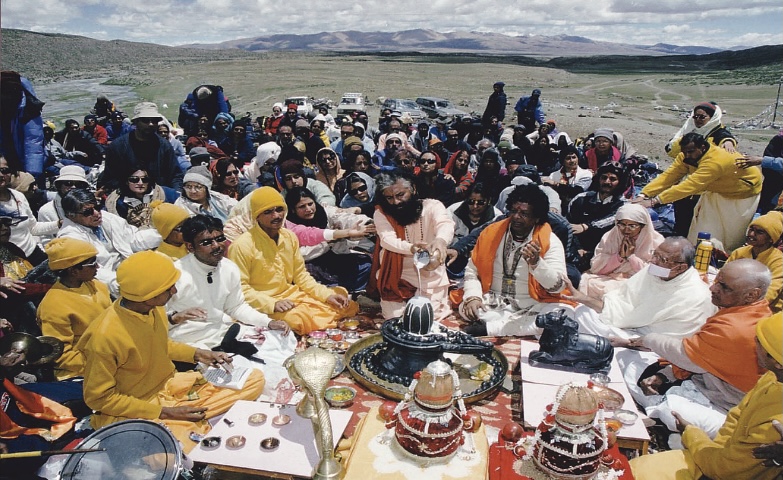BY ISANI ALAHAN
The Chinese officials read our temperatures by computer as we filed through immigration at the Lhasa Airport a reminder of how the SARS scare had closed Tibet and the pilgrimage route to Mt. Kailash just months before. But here we were on July 5, 2003, a 200-strong entourage of pilgrims led by Swami Chidananda Saraswati (Muniji) of Rishikesh. We stayed at the Lhasa Holiday Inn for three days to acclimatize ourselves to the 11,000-foot altitude. I met the saints traveling with us, Shankaracharya Swami Divyanand Teerthji, Swami Gurusharanand Maharaj, Acharya Kishore Vyasji, Acharya Shrikant Vyasji (both Jains), Roopchandra Muniji and Rasyani Babaji. We meditated at the partially-restored Potala Palace of the Dalai Lama, and learned breathing techniques to fend off altitude sickness. Many people were sick and even considered ending their journey, but most adapted in the three days.
This pilgrimage was to be quite special for Muniji, because he would soon dedicate the Parmarth Manasarovar Medical Clinic and Ashram on the shores of Lake Manasarovar, just a few miles from Mt. Kailash. It is the first time Chinese officials have allowed such construction in the area. Muniji was inspired to build the facility during his 1998 pilgrimage when he became aware that there were no medical facilities for hundreds of kilometers. Local villages were suffering from basic treatable ailments, and sick pilgrims likewise fended for themselves. After nearly three years of discussion with the Chinese government, an agreement was signed in December, 2000. It stated, in part, “Under the vision, inspiration and leadership of His Holiness Pujya Swami Chidanand Saraswati, Indian Heritage Research Foundation has agreed to provide the Bureau of Foreign Affairs and Tourism of Ngari Prefecture of Tibet Autonomous Region, People’s Republic of China, with a clinic and Tourist Rest House (ashram) in the holy area of Lake Manasarovar and Mt. Kailash.”
From Lhasa we drove through the desolation of the Himalayas for three days, a terrain similar to the high desert of the Sierra Nevada in the western US where I grew up. With supplies of food, water and the portable kitchen, the trucks drove ahead of us and, amazingly, a fabulous rice and curry feast awaited us after each day of trailblazing on bumpy, dusty roads, fording streams and clinging to cliffs in our four-wheel-drive Toyotas. It had been raining for a week when we arrived and set up camp near the newly built facilities at Lake Manasarovar. I looked forward to circumambulating Mt. Kailash a difficult 33-kilometer hike on foot. But in the morning we learned snow had blocked the route, trapping a party of nine pilgrims. One died, and the others were rescued by Sherpas on ponies. It was a great disappointment. The closest we came to the sacred mountain was at Tarboche, where an elaborate outdoor Siva puja was conducted. At its completion, the clouds parted from Kailash and the group had a full hour’s darshan (sight).
During the Guru Purnima puja, on July 13, I felt very lucky to be seated near the saints and in front of the Swambhu Siva Lingam during the final offering of lights. During Muniji’s talk about the guru in our life, I was overwhelmed and tears streamed down my face as I reflected on my guru, Satguru Sivaya Subramuniyaswami, his influence in my life and the magic of Lord Siva which brought me to this sacred place.
That afternoon was the official opening of the ashram and clinic, which many local villagers attended. On the 15th we circumambulated the lake, with Mt. Kailash constantly in clear view. At the point where Kailash towered directly behind the lake, we stopped for a sacred bath while the rishikumars residents of the ashram’s Rishikesh school chanted Vedic mantras. As we left the following day, it began to snow. Muniji shared with us that to him the yatra was not only circumambulation of Siva’s abode, it was also a cross-cultural experience, an opening of doors for others to come to Kailash, the beginning of a process to bring modern irrigation, conveniences and an easier existence for the Tibetan villagers in the remote Himalayas.
